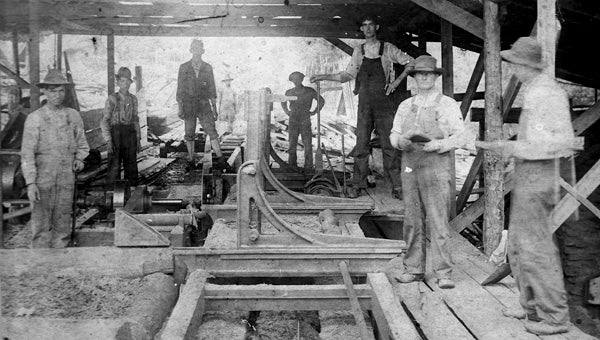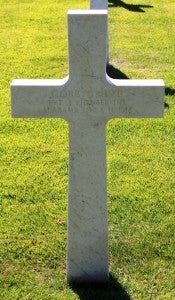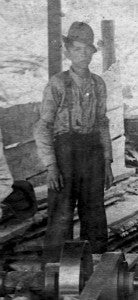Community Correspondent: Leaving home never to return
Published 2:34 pm Friday, October 9, 2015

Corb Driver, second from left, had left school and was working alongside his father, one brother and an uncle in saw mills. Lewis Thomas, far left, ran the mill. The owner of the mill, D.S. Robinson, is pictured on the right holding a little book. The last man on the right is John Thomas Driver, Corb Driver’s older brother, and the men in the background include Corb Driver’s father, John H. Driver, Ben Higgins and Robert Peters. One man pictured is unknown. (Contributed photos)
By Ola Taylor | Community Correspondent
The monument at the Chilton County Courthouse honoring our war dead lists 30 young men lost in World War I. One name not appearing on the list is Corb Driver.
Driver’s draft registration lists his birthplace as Verbena, but by then he was living just across the line in Autauga County.
Corb Driver, sometimes listed as Corbin, Corbet or Corby in the census, was born in 1895 to John H. and Martha Fulmer Driver, the youngest of their eight children, all sons.
By his early teens he had left school and was working alongside his father, one brother and an uncle in saw mills. In a picture made at one of the mills on Cargile Creek, he faces the camera, which captured his solemn, young face.
In April 1917, the United States entered the war.
On June 5, Corb registered for the draft with the Autauga County board, which listed him as age 21, short, medium build, brown eyes, auburn hair and employed by the Rollins Lumber Mill as a sawyer.
It is very likely, given his economic status, that Corb Driver had never been far from his home in the Verbena/Marbury area, maybe no farther than Montgomery at the most. But, when he was called up, Driver left home never to return.
The young private was assigned to Company K of the First Pioneer Infantry, a group made up originally of men from New York whose ranks were increased by men from Kentucky, Alabama, Florida, Georgia and other states. The War Department chose men “experienced in life in the open, skilled in woodcraft and simple carpentry” for Pioneer groups. They were “trained and armed for construction or combat” and would be expected to “clear passages through woods or other obstructions, improve roads and make bridges.” As it turned out, another duty that fell to them was burying the dead to clear a path for the troops.

A picture of Corb Driver’s grave, which is in the Meuse-Argonne American Cemetery in Lorraine, France, about 4,700 miles from his birthplace.
Corb Driver and his fellow soldiers trained at Camp Wadsworth, South Carolina in the early months of 1918 and on July 1 boarded a train for New York. On July 9, they boarded a ship for France and arrived on the July 18.
Driver was used to a life of hard work and had received rigorous training at Camp Wadsworth, but it’s doubtful that any of that prepared him for what he and his fellow Pioneers faced. By late September, the Allies were engaged in the Meuse-Argonne Offensive. To prepare the way for the troops, on Sept. 26, “Pioneers were collecting stone from a ruined village with their bare hands and throwing it on the road and every handful was worth a hundred bullets,” according to Chester W. Davis’s history of this infantry.
On October 11, a platoon of Company K was assigned to build camouflage screens along a road. Caught in a German barrage, Corb and three of his comrades died exactly one month before the armistice that ended WWI. A white cross was placed in the Meuse-Argonne American Cemetery Lorraine, France, about 4,700 miles from his birthplace.
-Ola Taylor is a Community Correspondent for The Clanton Advertiser. She can be reached at olataylor@gmail.com.




